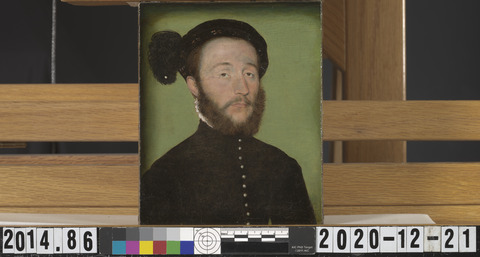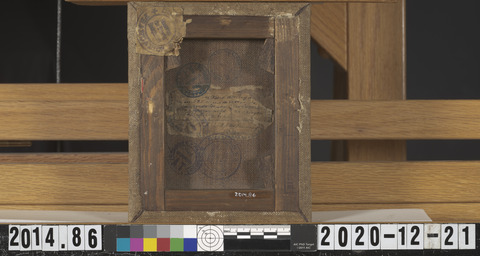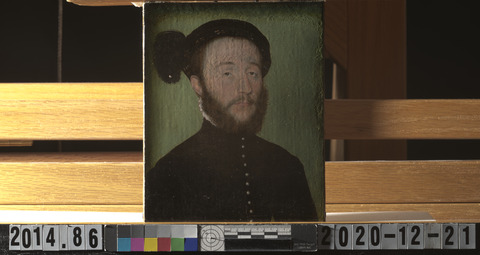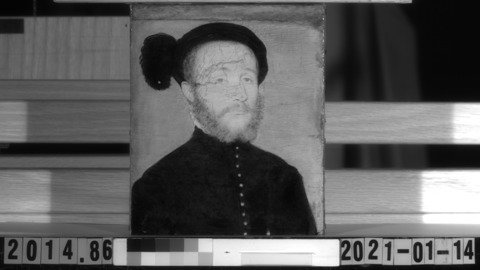Overview
Identification number: 2014.86
Artist: Corneille de Lyon
Title: Portrait of René du Puy du Fou
Materials: Oil on wood panel, transferred to canvas
Date of creation: About 1550
Previous number/accession number: C10028
Dimensions: 17 × 13.8 cm
Conservator/examiner: Roxane Sperber with contributions from Fiona Beckett
Examination completed: 2020
Distinguishing Marks
Front:
None
Back:
Item 1. Round purple stamp on square brown paper label, top left: “DOUANES FRANCAISES Recette de Paris Batignolles” (tech. fig. 1).
Item 2. Round blue stamp, upper portion of canvas: " DOUANES FRANCAISES…..AT" (tech. fig. 2).
Item 3. Round blue stamp, similar to item 2 but illegible, upper portion of canvas (tech. fig. 2).
Item 4. Octagonal label with decorative blue ribbon, center of canvas on top of another label: “Portrait de Réné du Puy du …né en 1528 marié Portrait de Réné du Puy du …né en 1528, marié á la veuve de Charles de Chabannes, Catherine de la Rochefoucauld. Voir crayon de Chantilly I.61. – no. 177 Ex des primitifs” (tech. fig. 3).
Item 5. Partial round purple stamp, on top of item 4: “DOUANES….Recette de Paris” (tech. fig. 3).
Item 6. Round purple stamp, lower portion of canvas: “DOUANES FRANCAISES…AT” (tech. fig. 4).
Item 7. Round purple stamp, lower portion of canvas: “DOUANES …” (tech. fig. 4).
Item 8. Partial rectangular purple stamp, lower portion of right stretcher: “MADE IN…” (tech. fig. 5).
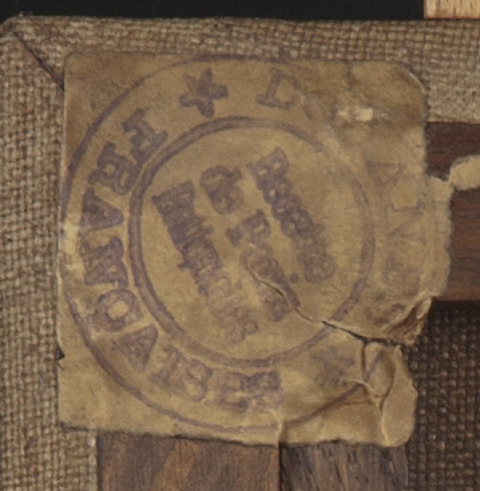
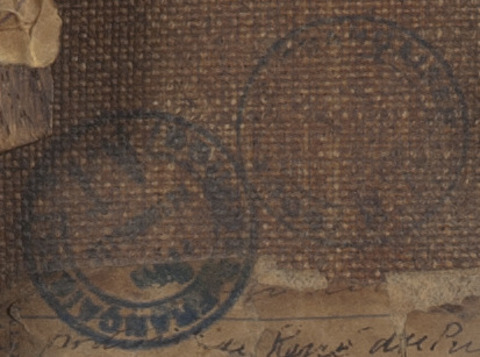
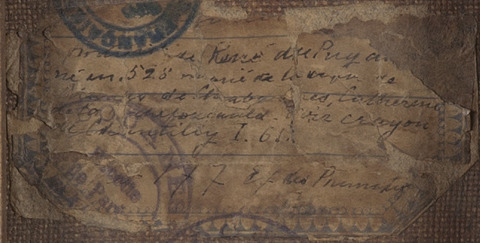
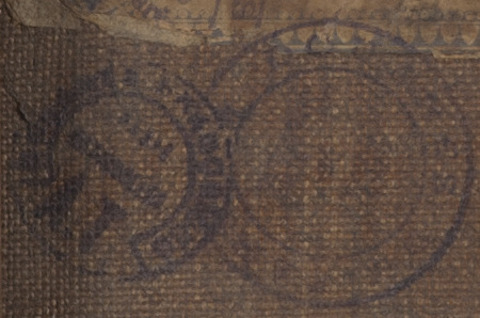
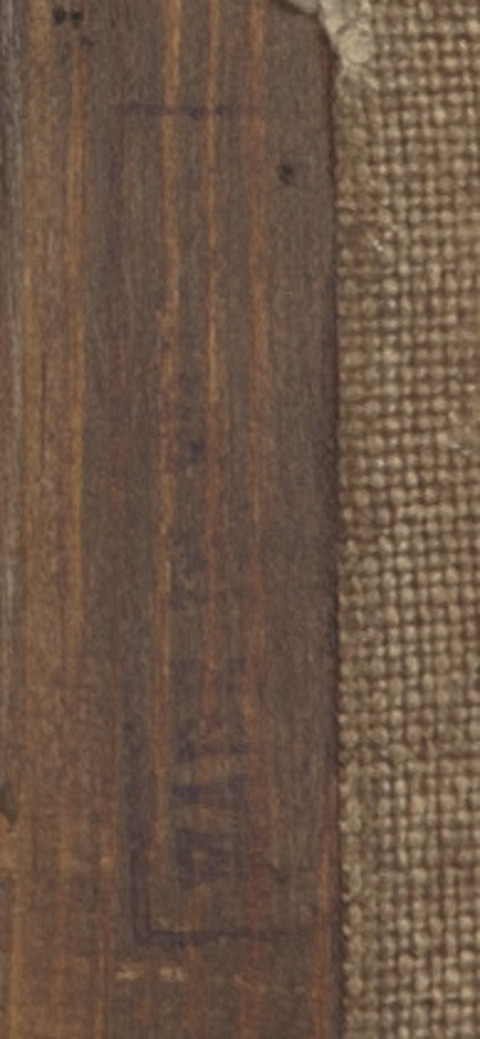
Other :
Item 9. Paper label in file, printed and handwritten in brown ink: “Exposition de Bruxelles/G. Siligmann [sic]. Rue de la Paix/No. 152/ CHENUE, EMBALLEUR/ 5, Rue de la Terrasse - PARIS (17e Arrt)/ R. C. Seine 27032/ Nom Corneille de Lyon/ Titre Portrait de René du Puy du Fou/ 28” (tech. fig. 6).
Item 10. Paper label in file, printed and handwritten in brown ink: “MM Jacques Seligmann & fils/9 rue de la Paix/Corneille de Lyon – ‘du Puy du Fou’/ CHEFS-D’OEUVRE/ DE/ L’ART FRANҪAIS/ 28” (tech. fig. 6).
Item 11. Paper label with corrugated edge in file, handwritten in black ink: “13931” (tech. fig. 6).
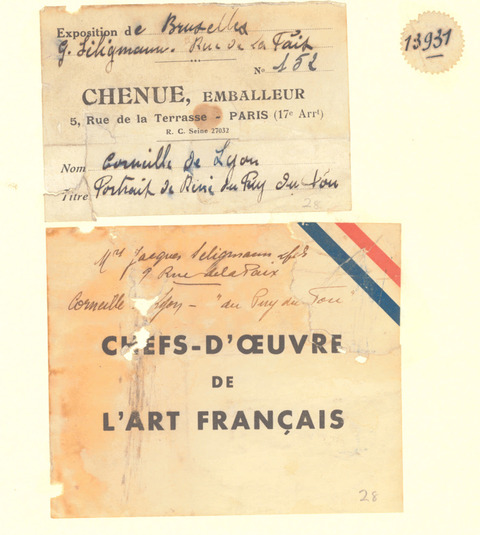
Summary of Treatment History
Physical evidence suggests the painting underwent numerous interventions prior to arrival at the IMA on long-term loan in 1971. These included a major structural intervention in which the painting was transferred from panel to canvas. The rationale for such an invasive treatment is unclear. Although the work has always been small, it is likely that the original support was trimmed, especially along the top edge, when the painting was transferred. A subsequent addition to the upper edge has returned the work approximately to its original size.
Documentation suggests a series of condition assessments and treatments were carried out on the collection about the time the works were moved from the Clowes residence to the IMA in 1971. A condition report by Paul Spheeris in October of that year, likely carried out before the paintings were relocated, described the painting as having two scratches in the bottom-left corner. He recommended cleaning for the sake of the work’s appearance but not for its safety.1
A second condition assessment was carried out upon arrival of the paintings at the IMA. This assessment described the work as in stable condition, and no work was deemed necessary. An X-radiograph of the painting was made at this time. Interestingly, this report described the painting as “oil on panel,” however French custom stamps on the back of the canvas suggest that the painting was transferred to canvas before leaving Europe. It is likely that the initial IMA assessment was done without examining the back.2 An undated record suggests the work was surface cleaned, “resurface[d] with 82,” and refitted into a corked frame.3
In 1974, a condition assessment, treatment, and investigation of the collection was carried out by the Intermuseum Conservation Association at Oberlin College. This report described this painting as being on canvas and documents the missing portion along the upper edge that had been overpainted. The report noted that the painting is structurally secure but has a discolored, heavy, natural resin varnish with a different crack pattern than the paint layer. Removal of the overpaint and surface coating was recommended to improve the appearance.4 However, this treatment does not appear to have been carried out at this time. In 1979, the painting was surface cleaned with a mixture of ivory soap flakes, distilled water, and benzene B264.5
The painting underwent a full treatment in 2019–2020. This treatment involved the removal of discolored varnish, mismatched retouching, and overpaint. A new varnish was applied, and losses were reintegrated through inpainting. The upper addition to the painting was reconstructed to create a dark edge consistent with other works from the Corneille de Lyon studio.
The painting was inspected in the Clowes Collection annual survey from 2011 to 2020.
Current Condition Summary
Aesthetically, the painting appears in good condition after the 2019 treatment. Although significantly altered, the structure of the painting is also in stable condition.
Methods of Examination, Imaging, and Analysis
| Examination/Imaging | Analysis (no sample required) | Analysis (sample required) |
|---|---|---|
| Unaided eye | Dendrochronology | Microchemical analysis |
| Optical microscopy | Wood identification | Fiber ID |
| Incident light | Microchemical analysis | Cross-section sampling |
| Raking light | Thread count analysis | Dispersed pigment sample |
| Reflected/specular light | X-ray fluorescence spectroscopy (XRF) | Fourier-transform infrared spectroscopy (FTIR) |
Transmitted light | Macro X-ray fluorescence scanning (MA-XRF) | Raman microspectroscopy |
| Ultraviolet-induced visible fluorescence (UV) | ||
| Infrared reflectography (IRR) | Gas chromatography–mass spectrometry (GC-MS) | |
| Infrared transmittography (IRT) | Scanning electron microscope-energy dispersive X-ray spectroscopy (SEM-EDS) | |
| Infrared luminescence | Other: | |
| X-radiography |
Technical Examination
Description of Support
Analyzed Observed
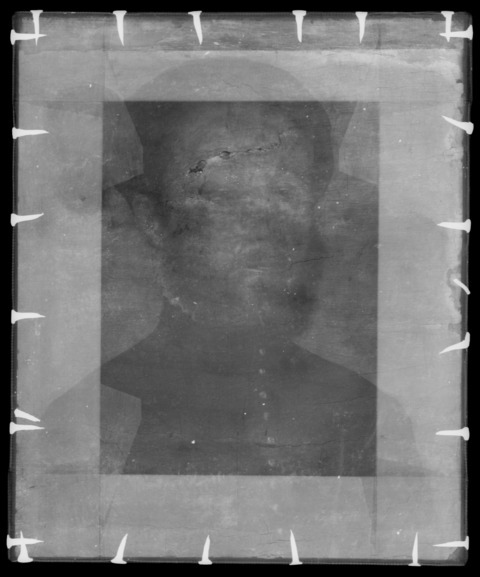
Material (fabric, wood, metal, dendrochronology results, fiber ID information, etc.):
The painting is currently on a canvas support, but it was originally on a horizontally oriented wood panel. At some point in its history, the painting was transferred to the fabric support. During the transfer process the original panel was thinned, leaving only the ground and paint layer. Possible residue of the wood panel remains visible in the X-radiography along the top edge (tech. fig. 7).
Characteristics of Construction / Fabrication (cusping, beveled edges of panels, seams, joins, battens):
The fabric support is a tightly woven linen.
Thickness (for panels or boards):
N/A
Production/Dealer’s Marks:
There are no dealer’s marks, but there are a significant number of French customs stamps and labels that were affixed before the painting was acquired by Dr. Clowes. These are applied to the back of the canvas and the stretcher, confirming the transfer to a canvas support was completed before the painting entered the Clowes Collection. See Distinguishing Marks section for a transcription of stamps and labels.
Attachment to Auxiliary Support:
The panel was transferred to canvas (likely with a strong hide-based glue), and a lining canvas was attached to the stretcher using evenly spaced iron nails.
Auxiliary Support:
Original Not original Not able to discern None
The auxiliary support is a four-member stretcher with mortise and tenon joins, and three of its eight keys remain in place.
Condition of Support
The current support is in stable condition. Without documentation, it is difficult to determine the state of the painting before the transfer or the impetus for such an invasive treatment. It is possible that the original support endured severe damage and required intervention. Transfers were sometimes performed to remedy extensive insect damage; however, the supports most frequently used in Northern Renaissance painting are not generally susceptible to that type of destruction. It is possible that extensive damage to the top portion of the original painting prompted its removal and replacement. However, it is equally possible that the painting was trimmed during the panel’s transfer to canvas.
In eighteenth- and nineteenth-century France, panel transfers were especially popular as a remedy for everything from curving, splitting, and insect damage to cleavage between the support and paint layer.6 On at least one occasion, a panel transfer was performed before the king and court as a display of a restorer’s expertise.7 Given the prevalence of panel transfers in France, the possibility that the transfer was done as a matter of course cannot be excluded.
Previous damages and losses are visible in the sitter’s face as well as on the edges of the painting. However, none of these damages is so severe as to require structural intervention to the support.
Description of Ground
Analyzed Observed
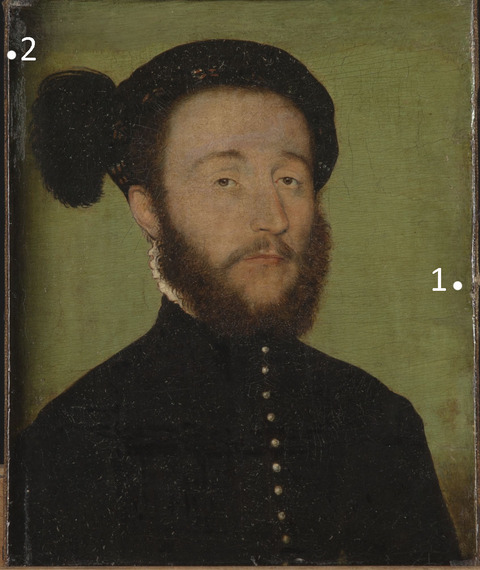
Materials/Binding Medium:
Cross section 1A shows the preparation layers in an area of light green paint (tech. fig. 9). The painting has a calcium carbonate ground (tech. fig. 10) followed by a thin layer of lead white imprimatura (tech. fig. 11). This ground structure is consistent with Northern European painting of this period.
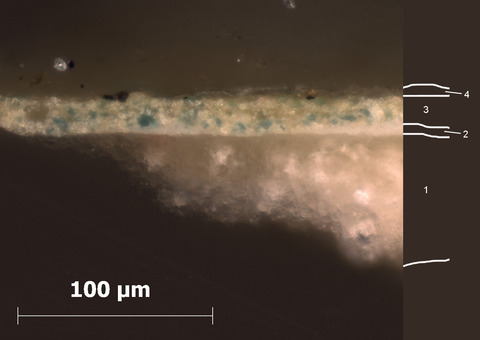
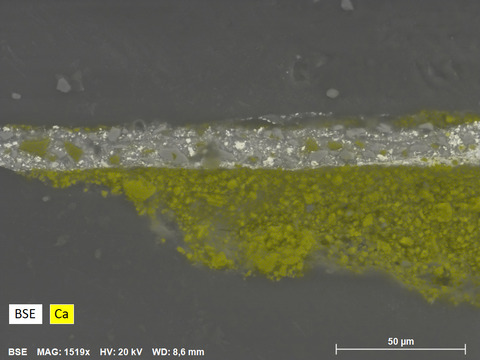
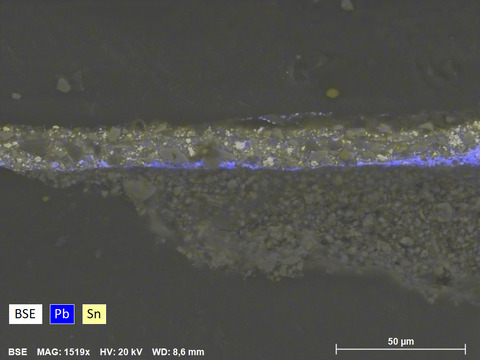
Color:
The ground, where seen along the edges and in cross section, is off-white. The imprimatura is bright white (tech. fig. 9).
Application:
The extremely smooth surface suggests that the ground was likely applied with a brush and then sanded flat before the brush application of the imprimatura.
Thickness:
The ground appears to be a single layer of medium thickness, approximately 60 µm. The imprimatura is applied extremely thinly and measures only a few microns in thickness.
Sizing:
There is no evidence of a size layer in the cross sections, but it was likely applied to the panel before that application of the ground.
Character and Appearance (Does texture of support remain detectable / prominent?):
The texture of the previous wood support as well as that of the canvas support is visible through the ground and paint layers.
Condition of Ground
The ground is in stable condition. The craquelure is consistent with that of a horizontal-grain wood panel painting, but there are also cracks consistent with that of paintings on canvas. The original ground layer would have been consistent with that of panel paintings and would not have needed to be very flexible. The transfer to canvas caused additional cracking due to the more flexible nature of the canvas support and its incompatibility with a ground layer that was originally applied to a panel painting.
The top portion of the painting (~2cm) was lost or damaged, and additional ground and paint layers along this edge were applied when the painting was transferred to canvas.
Description of Composition Planning
Methods of Analysis:
Surface observation (unaided or with magnification)
Infrared reflectography (IRR)
X-radiography
Analysis Parameters:
| X-radiography equipment | GE Inspection Technologies Type: ERESCO 200MFR 3.1, Tube S/N: MIR 201E 58-2812, EN 12543: 1.0mm, Filter: 0.8mm Be + 2mm Al |
|---|---|
| KV: | 22 |
| mA: | 3 |
| Exposure time (s) | 102 |
| Distance from X-ray tube: | 36″ |
| IRR equipment and wavelength | Opus Instruments Osiris A1 infrared camera with InGaAs array detector operating at a wavelength of 0.9–1.7µm. |
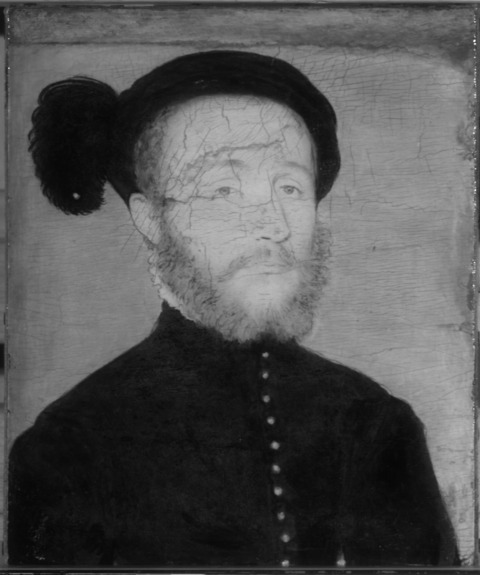
Medium/Technique:
The infrared reflectogram reveals some minimal underdrawing, particularly in the man’s face (tech. fig. 12). The artist likely used a dry carbon-containing medium (possibly charcoal or black chalk) to create these fine outlines. The underdrawing is almost entirely observable in visible lighting due to the thin application of the paint.
Pentimenti:
The painting appears to have carefully followed the original drawn design, and no pentimenti are discernible.
Description of Paint
Analyzed Observed
Application and Technique:
The paint was thinly and delicately applied, particularly the fine brushstrokes used for the face, hair, and buttons. The clothing and hat are more loosely painted. The artist would have originally created a dark gradient to the left and top edges of the painting to create a sense of depth.8 The gradient was not created by applying the dark green edge over the light green layer (tech. fig. 13); rather, the two areas of color were applied directly to the imprimatura, and the subtle blending of the light and dark shades was created using a wet-in-wet technique.
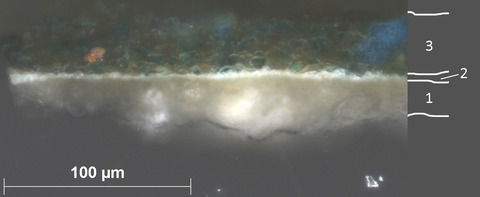
The painting is consistent with other Corneille de Lyon portraits in both the painting style and palette choice, including the prominent green background.
Painting Tools:
Fine brushes
Binding Media:
Oil (untested)
Color Palette:
XRF analysis detected a limited range of pigments and suggests the color palette is composed of lead white, iron oxide (earth pigments), lead-tin yellow, copper-containing blue and green pigments, and vermilion (tech. fig. 20, table 1). A strong peak for copper was detected in the cool shadows of the figure’s skin, suggesting azurite was added to create shadows. Although not able to be confirmed using XRF, a carbon-based black was used widely in the clothes and hat of the figure.
Cross sections were taken from light and dark areas of the background. Cross section 1A shows the composition of the light green paint in the background (tech. fig. 14; for cross section location, see tech. fig. 8). The layer is composed of a copper-containing green pigment, likely copper resinate or oleate, mixed with lead-tin yellow (tech. fig. 15). Lead white does not appear to be in the mixture, as all areas of lead in the paint layer correspond to areas of tin. There are also large, transparent particles rich in calcium and magnesium (tech. figs. 15, 16). This mixture is identical to that found in cross section 2 of Portrait of Marie de Lorraine. Raman microspectroscopy on that painting confirmed the magnesium- and calcium-rich particles are dolomite, suggesting that marble dust may have been added to the paint, possibly as a filler.

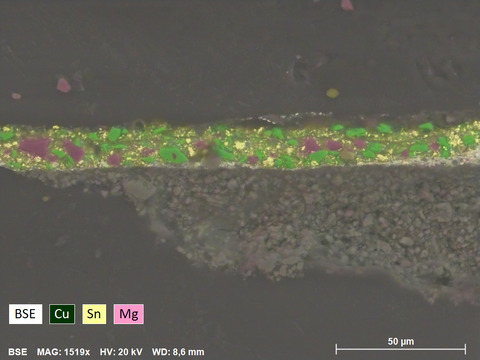

Cross section 2B is taken from an area of the dark green edge (see tech. fig. 8). No ground is present on the sample, and layer 3 and layer 4 are composed of retouching and varnish (tech. fig. 17). EDS analysis of layer 2 reveals a matrix of copper-containing pigment (green), likely copper resinate or oleate, mixed with a large proportion of particles rich in calcium (yellow) and magnesium (pink), and a small proportion of aluminosilicates (tech. figs. 18, 19). No lead (blue) or tin (light yellow) is present in the dark green matrix, although lead white is present in the imprimatura (layer 1) (tech. fig. 18).
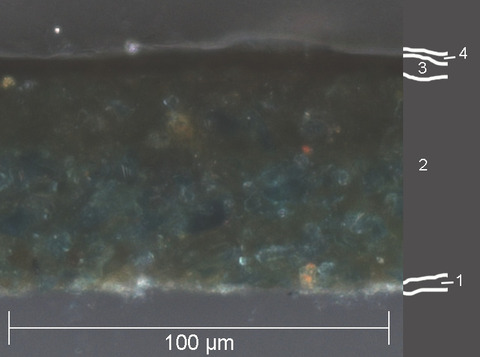
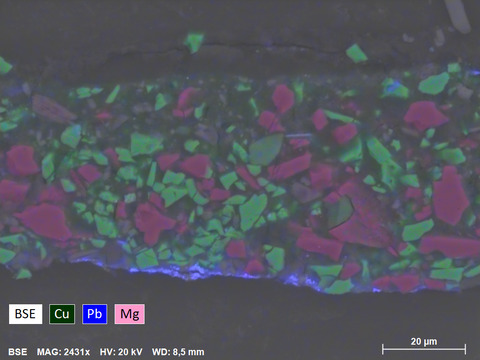
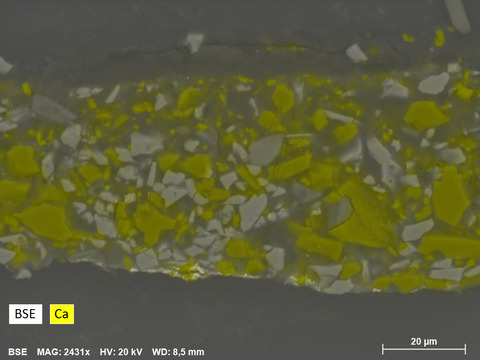
XRF Analysis:
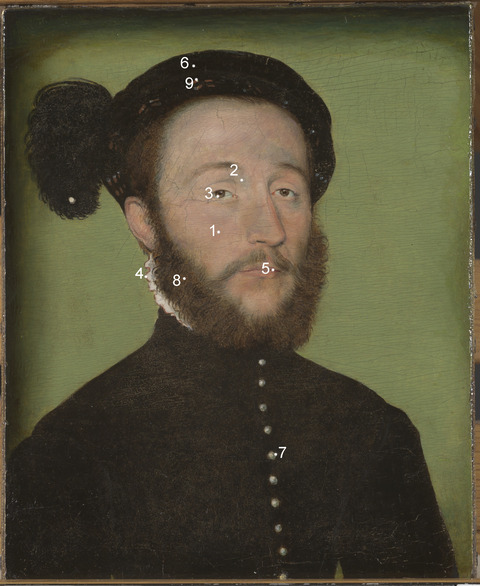
| Sample | Location | Elements | Possible Pigments |
|---|---|---|---|
| 1 | Skin tone | Major: Pb Minor: Cu, Hg Trace: Ca, Fe | Lead white, copper-containing green and/or blue pigment, vermilion, trace of calcium from ground layer, trace of iron oxide (earth pigments). |
| 2 | Skin tone shadow | Major: Pb, Cu Minor: Ca, Fe Trace: Hg | Lead white, copper-containing green and/or blue pigment (likely azurite), vermilion, trace of calcium from ground layer, trace of iron oxide (earth pigments). |
| 3 | Brown eye | Major: Ca, Pb, Cu Minor: Fe Trace: Cd | Lead white, calcium from ground layer, copper-containing green and/or blue pigment, iron oxide (earth pigments), cadmium from inpainting. |
| 4 | Ruff outline | Major: Pb Minor: Ca, Cu Trace: Fe, Hg | Lead white, possible red lead, copper-containing green and/or blue pigment, calcium from ground layer, trace of iron oxide (earth pigments), trace of vermilion. |
| 5 | Red lips line | Major: Pb, Ca Minor: Cu, Hg, Fe Trace: K | Lead white, calcium from ground layer or red lake mordant, vermilion, copper-containing green and/or blue pigment, iron oxide (earth pigments). |
| 6 | Black in hat | Major: Pb, Ca Minor: Cu, Fe Trace: K | Lead white, carbon black (could not be confirmed using XRF), calcium from ground layer, copper-containing green and/or blue pigment, iron oxide (earth pigments). |
| 7 | Button shadow | Major: Pb, Cu Minor: Ca Trace: Fe | Lead white, copper-containing green and/or blue pigment (likely azurite), calcium from ground layer, trace of iron oxide (earth pigments). |
| 8 | Brown beard | Major: Ca, Pb, Cu Minor: Fe Trace: | Lead white, copper-containing green and/or blue pigment, calcium from ground layer, iron oxide (earth pigments). |
| 9 | Yellow on hat | Major: Pb Minor: Hg, Cu, Ca, Sn Trace: Fe | Lead white, lead-tin yellow, copper-containing green and/or blue pigment, vermilion, calcium from ground layer, trace of iron oxide (earth pigments). |
Table 1: Results of X-ray fluorescence analysis conducted with a Bruker Artax microfocus XRF with rhodium tube, silicon-drift detector, and polycapillary focusing lens (~100μm spot).
*Major, minor, trace quantities are based on XRF signal strength not quantitative analysis.
Surface Appearance:
The paint surface is smooth with no areas of impasto.
Condition of Paint
Following the 2019 treatment, the paint layer is in good condition. A craquelure pattern consistent with that of horizontal wood grain is present in both the ground and paint layers. A large loss in the forehead of the figure can be observed in the X-radiograph and the photograph of the painting during treatment (tech. fig. 21). This loss affects both the paint layer and ground. The 2019 treatment addressed this area of loss and integrated severely abraded areas of the figure’s jacket. The gradient along the upper edge of the painting was reconstructed to more accurately reflect the appearance of the original composition.
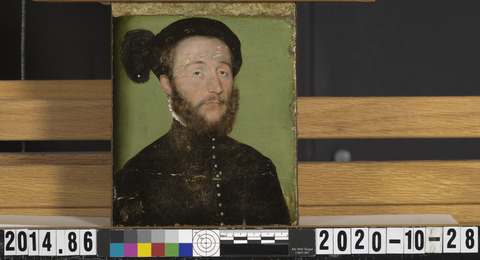
Description of Varnish/Surface Coating
Analyzed Observed Documented
| Type of Varnish | Application |
|---|---|
| Natural resin | Spray applied |
| Synthetic resin/other | Brush applied |
| Multiple Layers observed | Undetermined |
| No coating detected |
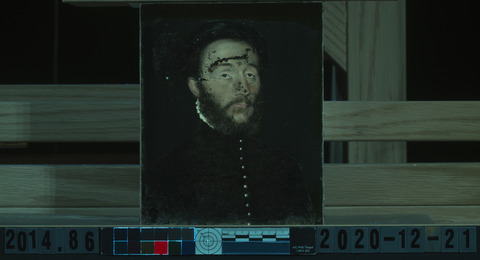
A synthetic varnish composed of 30% 1:4 Paraloid B-72: Larapol A81 in Shellsol A100 was applied during the 2019 treatment. The painting was inpainted using Gamblin Conservation Colors in Larapol A81. Removal of the overpaint across the top edge during the 2019 treatment revealed the edge of a gradient that would have originally created a transition to a dark green top edge, similar to that of the left edge. Therefore, the decision was taken to recreate this gradient using inpainting. Further inpainting was applied in the figure’s coat, forehead, and face.
Condition of Varnish/Surface Coating
The varnish and inpainting are in good condition following the 2019 treatment. The varnish is clear and well saturating, and the inpainting now matches the surrounding paint layer. Furthermore, the reconstruction of the upper portion restored the intended framing of the man’s face, in keeping with other works from the Corneille studio (tech. fig. 22).
Description of Frame
Original/first frame
Period frame
Authenticity cannot be determined at this time/ further art historical research necessary
Reproduction frame (fabricated in the style of)
Replica frame (copy of an existing period frame)
Modern frame
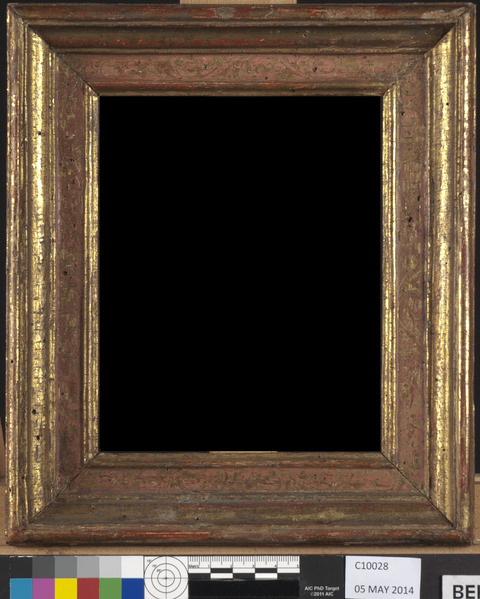
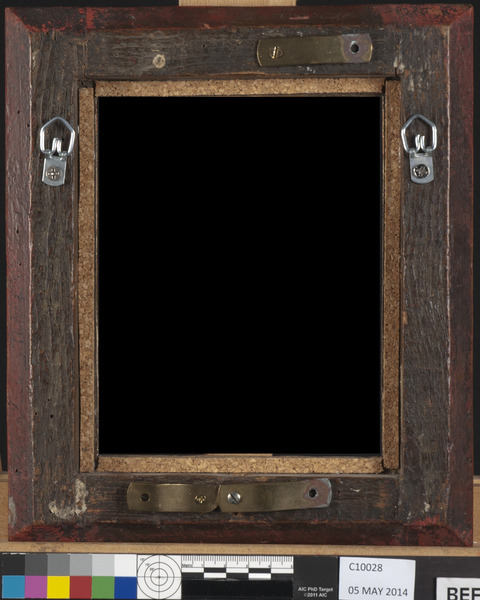
Frame Dimensions:
Outside frame dimensions: 24.5 × 21.3 × 4.3cm
Sight size: 16.3 × 12.8 cm
Distinguishing Marks:
None
Description of Molding/Profile:
As per the observations of historian and frame specialist Timothy Newbery, the frame consists of gilt oak with imitation craquelure and pale red sgraffito on the frieze (tech. fig. 23).9 The style of the frame is seventeenth-century French, but the frame was likely constructed in about 1970 in New York. The back joints are half-lapped (tech. fig. 24).
Condition of Frame
The frame is in good condition.
Notes
-
Paul A.J. Spheeris, “Conservation Report on the Condition of the Clowes Collection,” 25 October 1971, Conservation Department Files, Indianapolis Museum of Art at Newfields. ↩︎
-
Martin Radecki, Clowes Collection condition assessment, undated (after October 1971), Conservation Department Files, Indianapolis Museum of Art at Newfields. ↩︎
-
This report may date to when the painting first entered the IMA. The material described is likely Paraloid B-72, an EA/MMA resin. ↩︎
-
Intermuseum Conservation Association, “Clowes Collection Conservation Report,” C10028 (2014.86), 8–10 April 1974, Conservation Department Files, Indianapolis Museum of Art at Newfields. ↩︎
-
Memorandum from Martin Radecki to Bret Waller, “Conservation Work on Clowes Fund Collection,” 16 February 1996, Conservation Department Files, Indianapolis Museum of Art at Newfields. ↩︎
-
Ségolène Bergeon, Gilberte Emile-Mâle, Claude Huot, and Odile Baÿ, “The Restoration of Wooden Painting Supports: Two Hundred Years of History in France,” in The Structural Conservation of Panel Paintings: Proceedings of a Symposium at the J. Paul Getty Museum, 24–28 April 1995, ed. Kathleen Dardes and Andrea Rothe (Los Angeles: Getty Conservation Institute, 1998), 268. ↩︎
-
Ségolène Bergeon, Gilberte Emile-Mâle, Claude Huot, and Odile Baÿ, “The Restoration of Wooden Painting Supports: Two Hundred Years of History in France,” in The Structural Conservation of Panel Paintings: Proceedings of a Symposium at the J. Paul Getty Museum, 24–28 April 1995, ed. Kathleen Dardes and Andrea Rothe (Los Angeles: Getty Conservation Institute, 1998), 268. ↩︎
-
This dark gradient is still present on the left edge of the painting but was removed from the top edge when the painting was trimmed. This was recreated during the conservation treatment of 2020. ↩︎
-
Timothy Newbery, condition report on frame for C10028, 16 January 2012, Conservation Department Files, Indianapolis Museum of Art at Newfields. ↩︎
Additional Images
